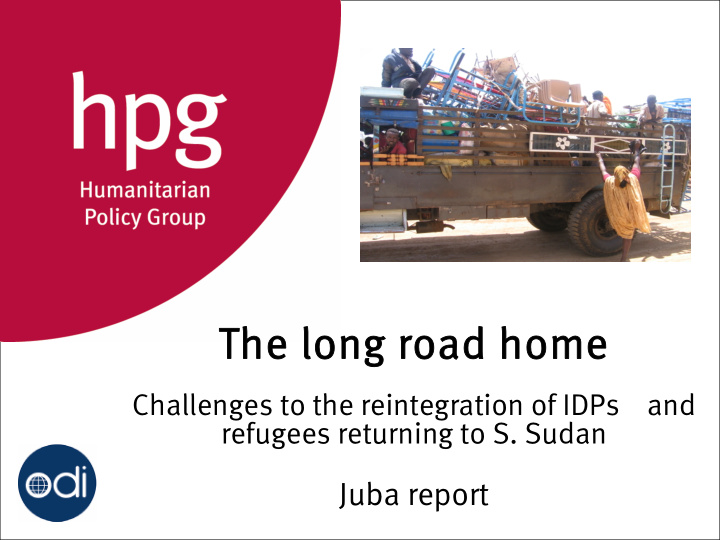



The long road home The long road home Challenges to the reintegration of IDPs and refugees returning to S. Sudan Juba report
The context – The context – Juba town uba town • Population increase • From garrison town to capital of Southern Sudan • A challenging transition for a young government
Social reintegration Social reintegration • Positive: families reunited, new skills • Negative: language differences; youth behaviour; antagonism residents/returnees • Resident population bearing the burden of reintegration: – hosting large numbers of returning relatives – severe pressure on household resources – relatives forced to stay even when they find work (no land) • Violence and intimidation by soldiers
Economic reintegration Economic reintegration • Rapidly growing economy, yet saturated labour market for unskilled • Challenges for returnees with skills in finding work • Lack of micro-credit opportunities and limitations of vocational training • Public sector employment: - integration of SPLM workforce and impact on payroll - language barrier, nepotism and corruption - unrealistic expectations of returnees • Private sector: - ‘cowboy capitalism’ - work permit issue - legislative vacuum
Services Services Population expansion → deterioration of services • • Service delivery dependent on NGOs: decline in funding = decline in services • Education: v. crowded schools; drop in quality; language problem • Health: reliance on JTH; lack of PHCCs in suburbs • Water: reliance on the Nile with serious consequences • Basic services personnel challenges • Returnees used to higher levels of services in area of displacement • Lack of services in other areas of CES
Leadership and institutions Leadership and institutions • Tribal leadership shaped by urban context and GoS rule • Mistrust of urban Bari chiefs by GOSS • IDP and refugee chiefs not recognized on return; returnees not yet integrated into leadership structures • Uncertainty about new leadership structures at local level: awaiting local elections and new legislation
Land Land • Cornerstone of returnees’ reintegration • Land and property disputes • IDP occupation of abandoned property • plots being forcibly occupied by military or the powerful • multiple issuing of leases for one plot • unauthorised building on plots • illegal sale of land • long term occupancy without registration • women’s rights • Town planning (evictions) • Creation of new plots (Bari vs CES and GOSS) • Dispute resolution: hybrid system/contested chief role • Legislative vacuum
Conclusion Conclusion • The next few years will be crucial to the future stability and prosperity of Juba. • Successes must be built on and the lessons of failure learnt. • Head of UNMIS in S.S.: ‘ there is a real opportunity to make a difference here, but it needs serious investment ’.
Recommend
More recommend